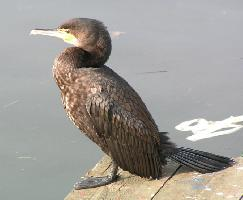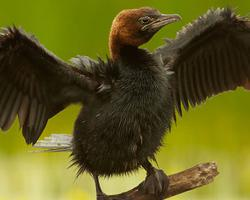
Súlyok és méretek
| Hossz | 70-tól 78-ig cm |
|---|
Veszélyeztetettség
| Rettenthetetlen |
Állatleírás
The Imperial Shag, scientifically known as Leucocarbo atriceps, is a captivating species of cormorant native to the southernmost reaches of the globe, particularly found along the coastlines and offshore islands of the Antarctic Peninsula, South Georgia, and the Falkland Islands. This bird is part of the Phalacrocoracidae family, which is renowned for its diverse and widespread members, all sharing a propensity for aquatic habitats.Characterized by its striking appearance, the Imperial Shag is a medium to large bird, typically measuring between 70 to 78 cm in length. It boasts a slender, elongated neck and a robust body, culminating in a long, hooked bill perfectly adapted for its piscivorous diet. The plumage of this bird is predominantly black and white, with the upper parts being glossy black, giving it a sleek, elegant look. The underparts, in stark contrast, are pure white, creating a dramatic visual dichotomy. Notably, during the breeding season, adults display an eye-catching crest on their heads, and their facial skin turns vivid blue, adding to their distinctive allure.
One of the most fascinating aspects of the Imperial Shag is its breeding behavior. These birds are highly social creatures, forming large colonies on rocky cliffs or islands, where they construct their nests out of seaweed, sticks, and feathers. These nests are meticulously maintained and reused year after year. The breeding season sees a flurry of activity within the colonies, as pairs engage in elaborate courtship displays, which include mutual preening, bill pointing, and a variety of vocalizations, strengthening the pair bond and ensuring cooperation in parenting duties.
Eggs are laid in clutches of two to five, with both parents sharing the responsibility of incubation, which lasts for about a month. Once hatched, the chicks are altricial, meaning they are born in a relatively undeveloped state and require significant parental care. They are fed by regurgitation and grow rapidly, fledging after about two months, though they continue to depend on their parents for food and protection for some time thereafter.
In terms of diet, the Imperial Shag is a skilled diver, using its powerful legs and webbed feet to propel itself underwater in pursuit of fish, squid, and crustaceans. These birds have been observed diving to depths of over 25 meters, though they typically forage in shallower waters. Their excellent diving ability, coupled with sharp eyesight, makes them adept hunters, capable of catching a wide variety of prey to sustain themselves and their offspring.
Despite their proficiency in the water, Imperial Shags face several threats, including habitat destruction, entanglement in fishing gear, and oil spills. Conservation efforts are underway in some regions to protect these birds and their habitats, ensuring that they continue to grace the southern oceans with their presence.
In summary, the Imperial Shag is a remarkable bird, embodying the wild beauty and resilience of the sub-Antarctic region. Its distinctive appearance, fascinating breeding behaviors, and adept hunting skills make it a subject of interest for ornithologists and nature enthusiasts alike. As efforts to conserve its populations and habitats advance, it is hoped that future generations will continue to marvel at this stunning species for years to come.
Előfordulási térkép

Hasonló állatok
Új állatfotók
Top 10 állat
- Dolphin gull (Leucophaeus scoresbii)
- Diana monkey (Cercopithecus diana)
- Moustached guenon (Cercopithecus cephus)
- Galápagos tortoise (Geochelone nigra complex)
- Japanese macaque (Macaca fuscata)
- Stone loach (Barbatula barbatula)
- Russian tortoise (Testudo horsfieldii)
- Greek tortoise (Testudo graeca)
- Common flying dragon (Draco volans)
- Vendace (Coregonus albula)


